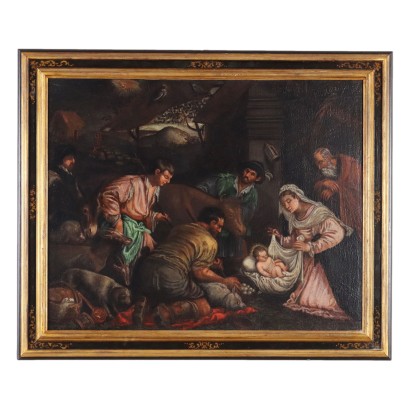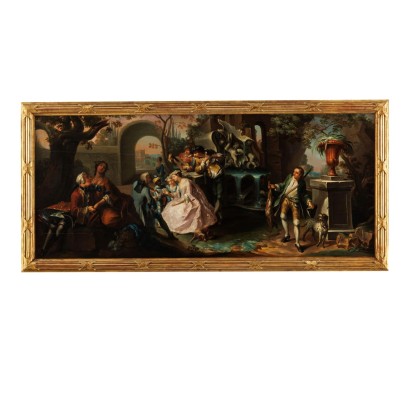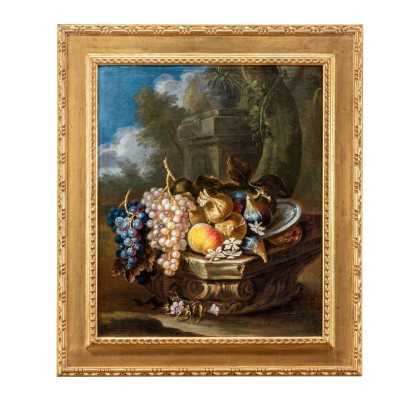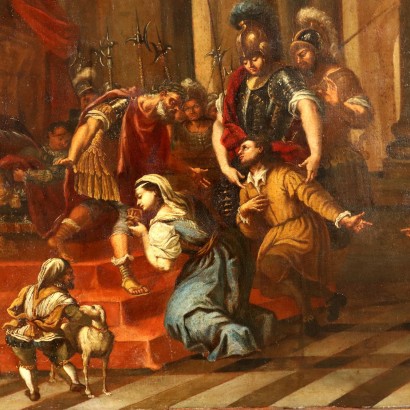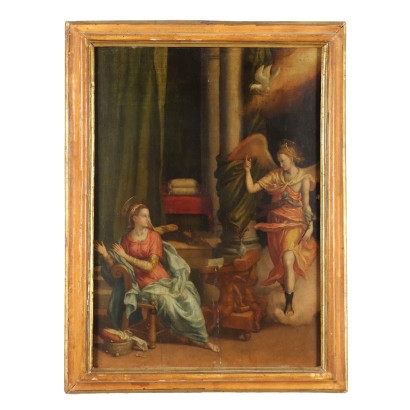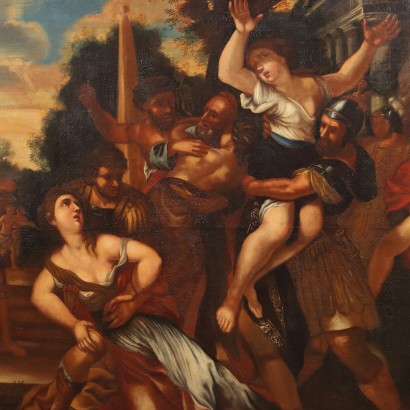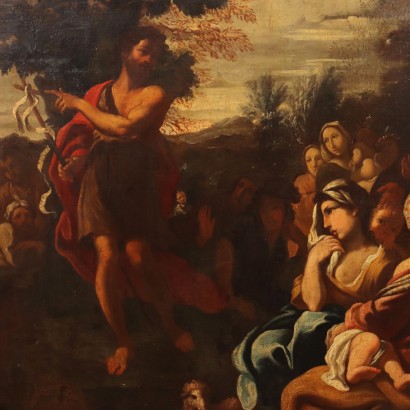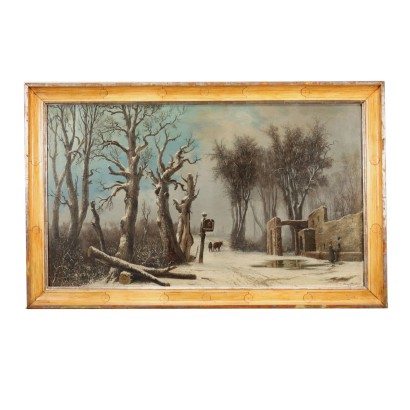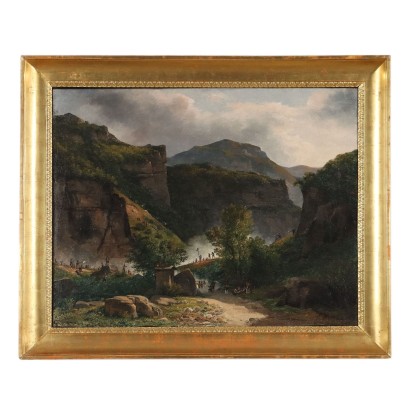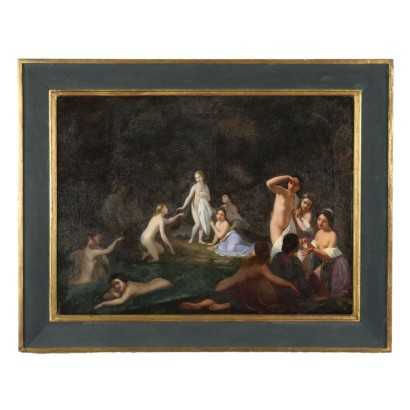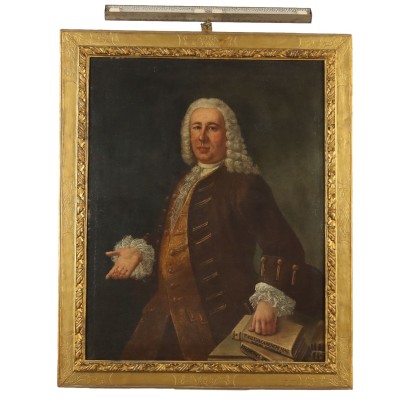Antique Painting Workshop of Francesco Bassano Italy XVI Century - Nativity
Features
Nativity
Artist: Francesco Dal Ponte, ovvero Bassano il Giovane (1549-1592) Workshop of
Artwork title: Natività
Age: 16th Century / 1501 - 1600
Subject: Sacred Subject
Artistic technique: Painting
Technical specification: Oil on Canvas
Description : Natività
Oil on canvas. Second half of the 16th century. The painting comes from the historical family collection of Count Castracane, as documented by the original autographed paper receipt of Francesco Bassano (attached to the work) which states: "Your Illustrious Count Castracane. Recipio de somesso sua somma de quinquaginta ducati per lo dipinto de mano mia de Nativitas Domini Nostri come Ella mhada ordenato. Dev.mo Obb.mo Servo suo Franciscus da Ponte de Bassano. Il die 12 decembre 1589". On the back of the frame there is also an inventory label at the top and the writing "proprietà Castracane" at the bottom. The aforementioned Count Castracane belongs to the noble family of Castracani degli Altelminelli di Fano, of Lucca origin. Francesco Dal Ponte da Bassano, known as Il Giovane, worked for many years in the important workshop of his father Jacopo, known as Bassano il Vecchio, before moving to Venice in 1578 where he opened his own personal atelier, while continuing to collaborate with the Bassano workshop, which was managed in the meantime by his brother Leandro after the death of his father. Towards the end of the 1580s, however, Francesco experienced a crisis that was also reflected in his allegorical production: in a progressive approach to the taste of his brother Leandro, the colour became lighter, losing strength, the forms dilated and simplified, the composition became fragmented. The production of the Bassano family was distinguished above all by sacred subjects, inserted however in rural settings, which lead to their being defined as biblical-pastoral. In this painting too, the Holy Family does not dominate the centrality of the scene, but is one of the two groups of very human figures that occupy the right part of the scene, while on the left stands out the group of shepherds with the animals of the countryside and the simple objects of everyday life. The rural context is also well defined by the surrounding objects, despite the hut of the birth being replaced by an architectural structure with marble columns, but of a colour that blends in with the other surrounding structures. The only spiritual elements are the angel - solitary! - who appears to the shepherds for the announcement, relegated to the top, small and barely hinted at; and the halo that surrounds the head of the Baby Jesus, who is also depicted peacefully asleep, unaware of what is happening around him and what awaits him. Characteristic of the production of his father's Bassano workshop were the richness and chromatic vivacity and the luminous contrasts, which however were toned down in Francesco, translating into more tenuous chromatic choices and simplified forms, losing part of their strength. This can also be seen in this work, which dates back to the last years of the artist's life, especially in the characters' clothes; note in particular how Mary's dress is no longer red as per tradition, a colour strongly symbolic of human pain, but is the same pink shade as the central shepherd's tunic, almost as if to underline the Madonna's belonging to humble and simple humanity. Moreover, Francesco Bassano in his last period, due to his health compromised by serious hypochondria (he committed suicide in 1592), received commissions for works that were only partially executed by him, but delegated at least partially to his assistants. This indicates that the work was commissioned to him and came from his workshop, as his autographed declaration states, but probably not made directly by the master, but rather by one of his collaborators. The painting has been restored and relined. It is presented in an antique wooden frame from the late 18th - early 19th century.
Product Condition:
Product in good condition, shows small signs of wear. We try to present the real condition as completely as possible with the photos. If some details are not clear from the photos, what is reported in the description is valid.
Frame Size (cm):
Height: 91
Width: 11
Depth: 4
Artwork dimensions (cm):
Height: 75
Width: 93,5
Additional Information
Artist: Francesco Dal Ponte, ovvero Bassano il Giovane (1549-1592)
Born in Bassano on 5 January 1549 to Jacopo and Elisabetta Merzani, he began his painting career in the 1560s in his father's workshop, where he soon developed his own artistic personality, dedicating himself in particular to the biblical-pastoral genre, rural and domestic themes, showing a heavier touch and a new breadth in the drapery. He was a skilled imitator of his father, with whom he collaborated intensely; in the 1570s they signed a series of important works together. In 1578 Francesco moved to Venice where he opened his own workshop; in the same year, he was commissioned to paint four Battles for the ceiling of the Sala del Maggior Consiglio in the Doge's Palace, created with the help of Jacopo and completed in 1582. Alongside his activity for an official commission, Francesco continued to produce genre paintings and nocturnes, in which he had specialized in his father's workshop. As the years passed, Francesco moved away from the splendid colors of the Bassano school, adopting a regular hatching. In Venice he was knighted by the doge Grimani for whom he had painted a portrait, and from then on he used to sign himself by adding the title of "eques". In his last works he came very close to the style of his brother Leandro, in an elaborate mannerism with more dilated and simplified forms. Francesco Dal Ponte committed suicide in Venice on July 3, 1592.Age: 16th Century / 1501 - 1600
16th Century / 1501 - 1600Subject: Sacred Subject
Artistic technique: Painting
La pittura è l'arte che consiste nell'applicare dei pigmenti a un supporto come la carta, la tela, la seta, la ceramica, il legno, il vetro o un muro. Essendo i pigmenti essenzialmente solidi, è necessario utilizzare un legante, che li porti a uno stadio liquido, più fluido o più denso, e un collante, che permetta l'adesione duratura al supporto. Chi dipinge è detto pittore o pittrice. Il risultato è un'immagine che, a seconda delle intenzioni dell'autore, esprime la sua percezione del mondo o una libera associazione di forme o un qualsiasi altro significato, a seconda della sua creatività, del suo gusto estetico e di quello della società di cui fa parte.Technical specification: Oil on Canvas
The oil painting is a painting technique using powder pigments mixed with bases in inert and oils.Other customers have searched:
Se sei un appassionato d'arte, non perderti i nostri approfondimenti sul Blog Arte Di Mano in Mano e su FineArt by Di Mano in Mano - Arte:
Leggi di più
Ecco alcuni tra i principali articoli:Vedute
Falsi nell'arte antica
Un messaggio di fiducia per ripartire
La potenza espressiva dell'arte figurativa etiope
Breve Storia del Collezionismo
Giorgio Upiglio, maestro dei libri d'artista
Matthias Withoos detto "Calzetta bianca"
San Rocco pensaci tu - Classic Monday
Dai un'occhiata alle nostre rubriche di divulgazione sull'arte:
Epoche
Lavorazioni e tecniche
Mostre ed Eventi
Protagonisti
Se sei appassionato di pittura antica, con tutta probabilità gusterai le schede di questi stupendi quadri:
"Dio parla a Noè dopo il diluvio", Jacopo da Ponte, detto il Bassano, seconda metà XVI secolo
Crocifissione, maestro della misericordia dell'accademia, terzo quarto del XIV secolo
Erminia incontra i pastori, Camillo Gavassetti, Seconda metà anni Venti del XVII Secolo
Eroine dell'antichità, Francesco Conti, XVIII secolo
Hieronymus III Francken, La Negazione di Pietro, XVII secolo
Jefte e la figlia, Girolamo Forabosco e aiuti, XVII secolo
L'Accademia di Platone, piccolo arazzo, fine XVII - inizio XVIII secolo
Maddalena e San Giovanni Battista
Natura Morta, Bartolomeo Arbotori, XVIII secolo
Sacra Famiglia con San Giovannino, Bartolomeo Ramenghi, scuola di, prima metà XVI secolo
Testa Femminile, Andrea del Sarto, ambito di, post 1522
Uva, fichi, melagrana e pesche su un capitello - Maximilian Pfeiler, primo quarto XVIII secolo
Sapevi che l'arte può essere anche un ottimo investimento (e non solo per grandi portafogli)?
L'Arte tra Collezionismo e Investimento
FineArt: Arte come investimento
Product availability
The product can be seen at Cambiago
Immediate availability
Ready for delivery within 2 working days from ordering the product.

